I had intended to write a brief review of the Dragon 60369 Sherman “Cannon Ball,” a wading Sherman that landed at Utah Beach on D-Day. However, as I tried to understand where it fit in within the framework of the D-Day landings, I found that my knowledge of tank warfare on D-Day was quite limited. I had no real sense for how many tanks landed at each beach and how many were lost. I decided that, at the very least, I would get a rudimentary “big picture” grasp of tank landings at Utah Beach and try to understand the other four beaches at a later time. For those not interested, please skip to the photos below.
Sherman Tanks at Utah Beach
On D-Day, June 6, 1944, approximately 100 U.S. Army Sherman tanks attempted to land at Utah Beach in support of the 4th Infantry Division. The U.S. deployed two tank battalions at Utah Beach, the 70th and 746th – each consisting of 48 Sherman tanks.
The 70th Tank Battalion was comprised of three tank companies, each with 16 Sherman tanks. Companies A and B were equipped with Duplex Drive Shermans; Company C was made up of 16 wading Shermans, including 4 dozers. “Cannon Ball” was one of the wading tanks in Company C. (Note: Each tank battalion also had a D Company made up of Stuart light tanks.)
The 70th lost 9 Shermans during the landing — 5 DD Shermans and 4 Wading Shermans, including “Cannon Ball.” Throughout the day, the 70th lost another 7 tanks, for a total of 16. Thus, by the end of D-Day, the 70th had lost one third of its Sherman tanks.
The 746th Battalion, on the other hand, did not have Duplex Drive Shermans, and all 48 Wading Sherman tanks landed safely, though the Battalion did lose two Shermans throughout the day.
It bears mentioning that by the end of D-Day, all objectives at Utah Beach had been achieved and the area was securely under control of the Allies. This is in sharp contrast with Omaha Beach, where the Allies suffered tremendous casualties and did not reach all objectives.
The chart below provides context regarding how “Cannon Ball” fit within the organizational framework of the 70th Tank Battalion at Utah Beach on D-Day. (I made the chart for learners like me who want to visualize where a small piece fits into a larger whole. I’m just an amateur so please use at your own risk.)
The 70th Tank Battalion
Before we get to “Cannon Ball,” here are a few bullets on the storied 70th Tank Battalion, to which “Cannon Ball” belonged:
- Formed in July 1940, the 70th Tank Battalion was the first independent tank battalion in the U.S.
- The Battalion fought in every major U.S. campaign in WWII, beginning with North Africa, through Sicily, Italy, and France, and finally in Germany itself.
- While in Algeria, the 70th trained the Free French soldiers who later formed the 2nd French Armored Division.
- The 70th was called the “soixante-dix” (meaning “70”) by the French, a phrase that later appeared on the sash of their mascot, Joe Peckerwood.
- Among other achievements, the 70th participated in the D-Day invasion, the Battle of the Bulge, and eventually crossed the Rhine to see the end of the war in Germany.
- In Normandy, the 70th supported the famous 101st Airborne Division during combat at St. Mere Eglise.
- Considered the most experienced U.S. tank battalion, the 70th was one of the most decorated of the war and received a Presidential Unit Citation for its role in the invasion of Normandy.
The Actual Tank
Unfortunately, there isn’t much information specifically on “Cannon Ball,” other than a well-known photo of it stuck in a shell hole at Utah Beach (see photo below). Nonetheless, here are a few bullets on what little I could gather from books and various corners of the internet:
- On D-Day, “Cannon Ball” was one of 16 Sherman wading tanks in C Company of the 70th Tank Battalion.
- It landed at Utah Beach but got bogged down in a shell hole.
- “Cannon Ball” was pulled out of the hole and put back into action.
- The tank had been previously fitted with a T4 Whiz-Bang Demolition Rocket Launcher in advance of D-Day. Following tests, the U.S. Army concluded that the launcher presented a risk to the crew and decided to remove the launcher prior to D-Day.
- “Cannon Ball” is one of very few D-Day tanks with wading trunks for which we have reliable marking information. But beyond that, it’s representative of the hundreds of amphibious tanks that fought the waves to reach shore at Normandy. Numerous DDs failed to make it, particularly at Omaha, while most wading tanks made it to shore.
I searched numerous books and the internet and, as far as I know, the two photos below are the only existing photos of “Cannon Ball.” If anyone knows of any other pictures, I’d love to see them.
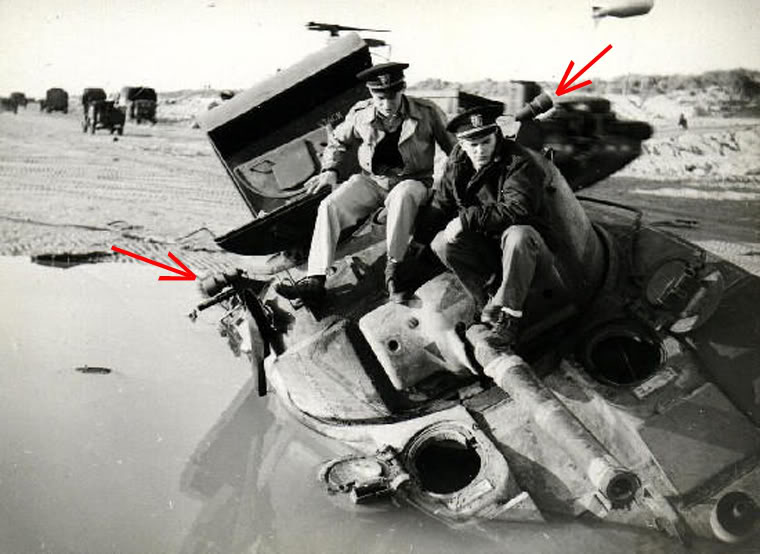
Of interest are the two mounting attachments on either side of the top of the turret. As mentioned, prior to D-Day “Cannon Ball” had been equipped with the Whiz Bang rockets (see profile below). The photo with the red arrows was posted by Steve Zaloga on another forum.
Note: Subsequent to publication of this article in December 2015, the photo of “Cannon Ball” below appeared in Armored Strike Force: The Photo History of the American 70th Tank Battalion in World War II, by Charles C. Roberts Jr., published July 1, 2016. It is posted here for discussion purposes under the fair use exception to the copyright laws.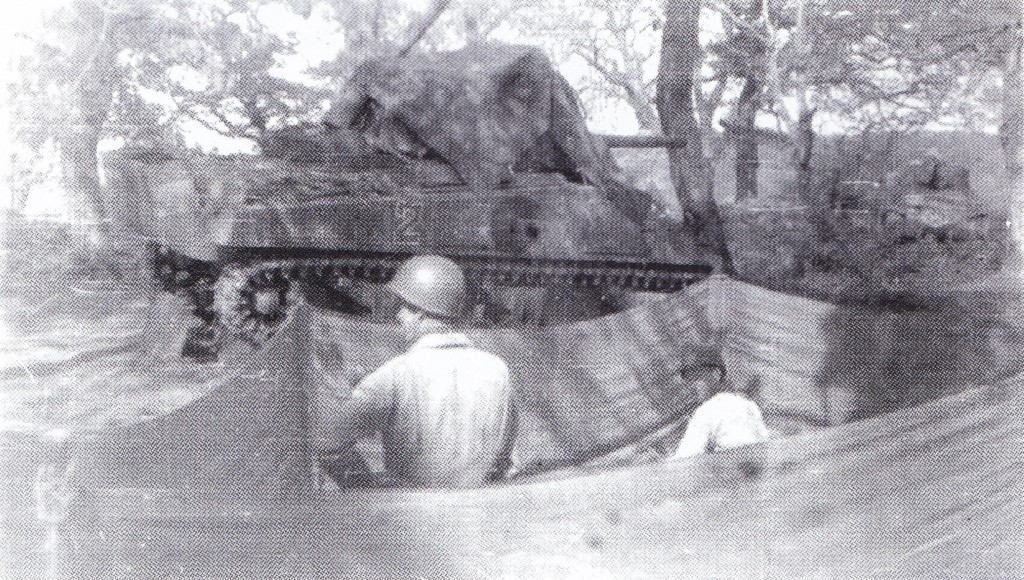 Though somewhat grainy, this photo is important historically in that it provides clear evidence that “Cannon Ball” survived the landing at Utah and lived to fight another day. It is similarly important for the modeler in that it confirms that the markings on the starboard side of the tank were symmetrical to those on the port side — an assumption usually made but often wrong. Note that the wading stacks were removed once the tank left the beach.
Though somewhat grainy, this photo is important historically in that it provides clear evidence that “Cannon Ball” survived the landing at Utah and lived to fight another day. It is similarly important for the modeler in that it confirms that the markings on the starboard side of the tank were symmetrical to those on the port side — an assumption usually made but often wrong. Note that the wading stacks were removed once the tank left the beach.
D-Day Shermans: Only “Cannon Ball” and “Carole” in 1/72
As far as I know, the only two D-Day Shermans in 1/72 scale are “Cannon Ball” and “Carole,” a Firefly with the 13th/18th Royal Hussars of the 27th Armored Brigade (Dragon 60250).
Dragon produced another Normandy M4, the 60370 “Tonto,” representing the U.S. 37th Tank Battalion, but that battalion didn’t arrive in Normandy until July 13, 1944, incidentally, at Utah Beach.
Dragon also produced another Normandy Firefly, the 60251 “Velikye Luki,” representing the Northamptonshire Yeomanry, but the unit didn’t arrive until June 12 at Gold Beach.
The Dragon 60369 “Cannon Ball” Model
- This is the only U.S. tank in 1/72 representing D-Day and makes a fine pair with “Carole,” its British D-Day counterpart.
- “Cannon Ball” is something of a unique tank in 1/72, as it’s the only tank with wading trunks that represents an actual tank. (Note: Dragon included a 75mm M4A1 with its LCM(3) but it has no markings and did not represent any particular tank.)
- The markings on “Cannon Ball” are colorful – and distinctive. The turtle is “Joe Peckerwood” the Truculent Turtle with a tanker’s helmet and the sash carries the words “soixante-dix” meaning “70” in French. (See inset in the profile.)
- The model is missing the T4 Whiz Bang brackets and gun sight pointed by red arrows in the photo above.
And finally, here are the photos:
Note the dark band around the turret. Mastic glue was used as a sealant to waterproof the tank over the opening of the turret ring and hatches.
Note the red number with white trim, a distinctive feature of the 70th. Note also the applique armor on the starboard side of the turret.
Note that the stars have been obscured. The black and white photo towards the bottom of this post graphically illustrates why.
Here’s a close-up of Joe Peckerwood the “Truculent Turtle” and the waterproofing label.
The U.S. Army began to obscure the white stars because they made excellent targets for German tank crews.
The Profiles
For those who love profiles, this is what “Cannon Ball” looked like on D-Day, from Zaloga’s Sherman at War (2): The U.S. Army in the European Theatre 1943-45.
This is what “Cannon Ball” looked like before D-Day, when it still had the Whiz Bang rockets, from Steve Zaloga’s U.S. Armored Funnies: U.S. Specialized Armored Vehicles in the ETO in World War II.
For those interested in what a wading dozer looks like, here’s a profile of the “Double Trouble,” also from the 70th Tank Battalion. The profile is also from Zaloga’s Funnies.
Here’s a lagniappe photo of the “Cannon Ball” with “Carole” (Dragon 60250), its British D-Day Sherman brother (or sister).
The Upshot
The Dragon 60369 M4 Sherman “Cannon Ball” is almost flawless. Other than the two mounting attachments for the Whiz Bang rockets missing on either side of the top of the turret, the 60369 is a fine and faithful representation of the actual Sherman tank that landed at Utah Beach on D-Day.
I hope to do a review of the Dragon 60250 Sherman Firefly “Carole” in the near future.

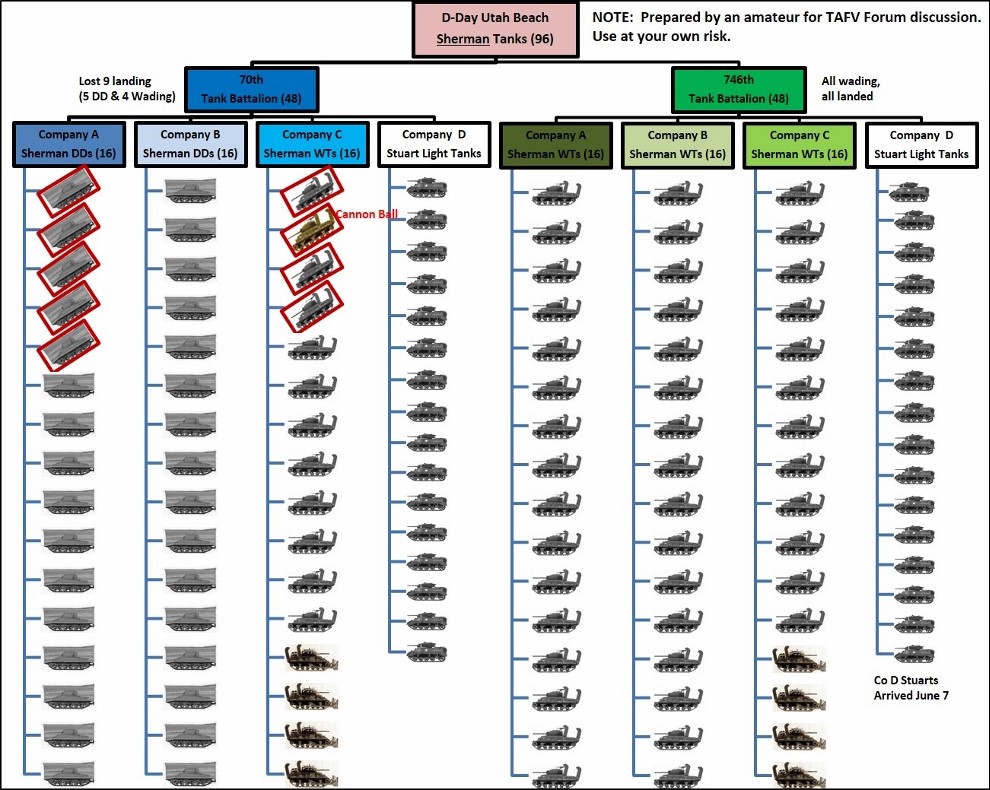
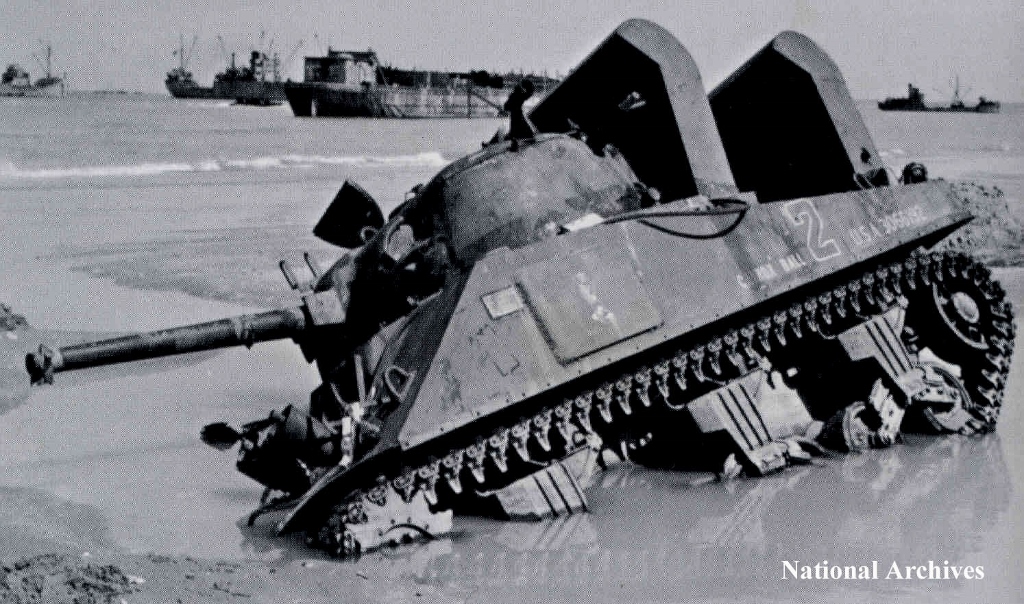
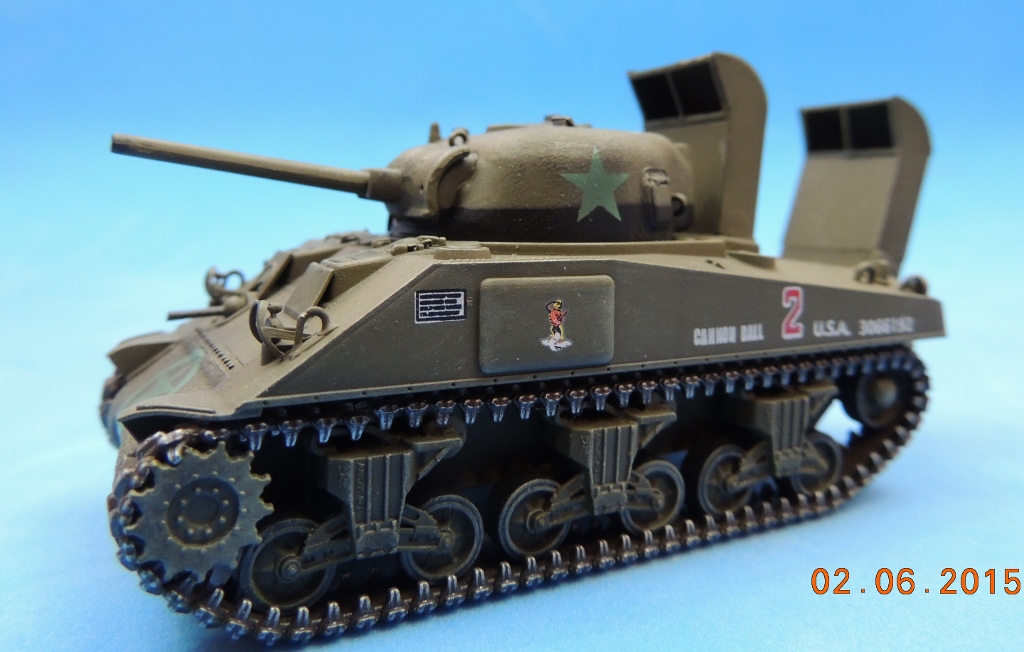

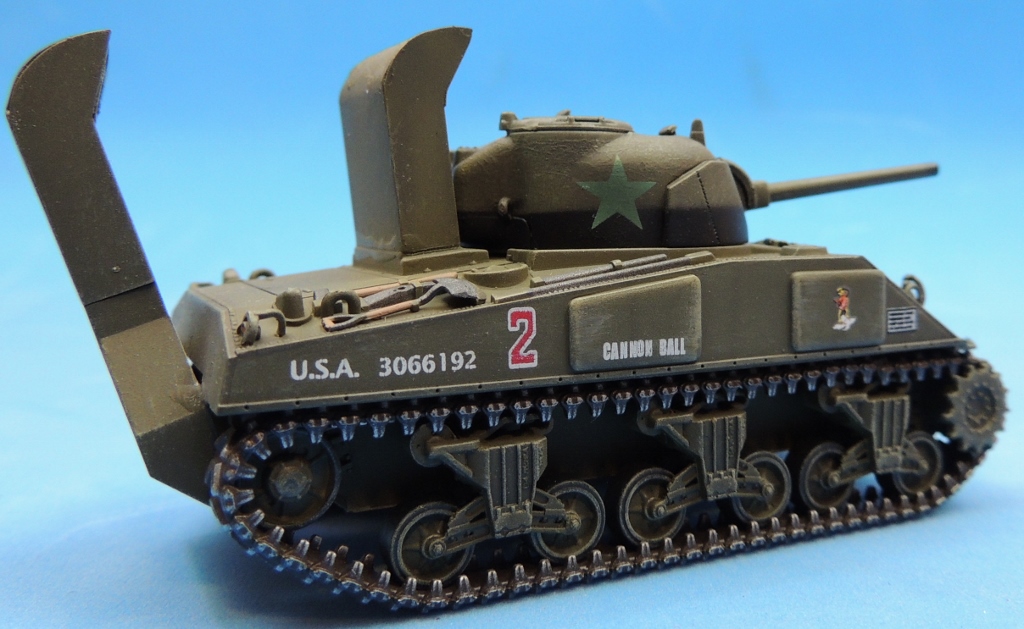
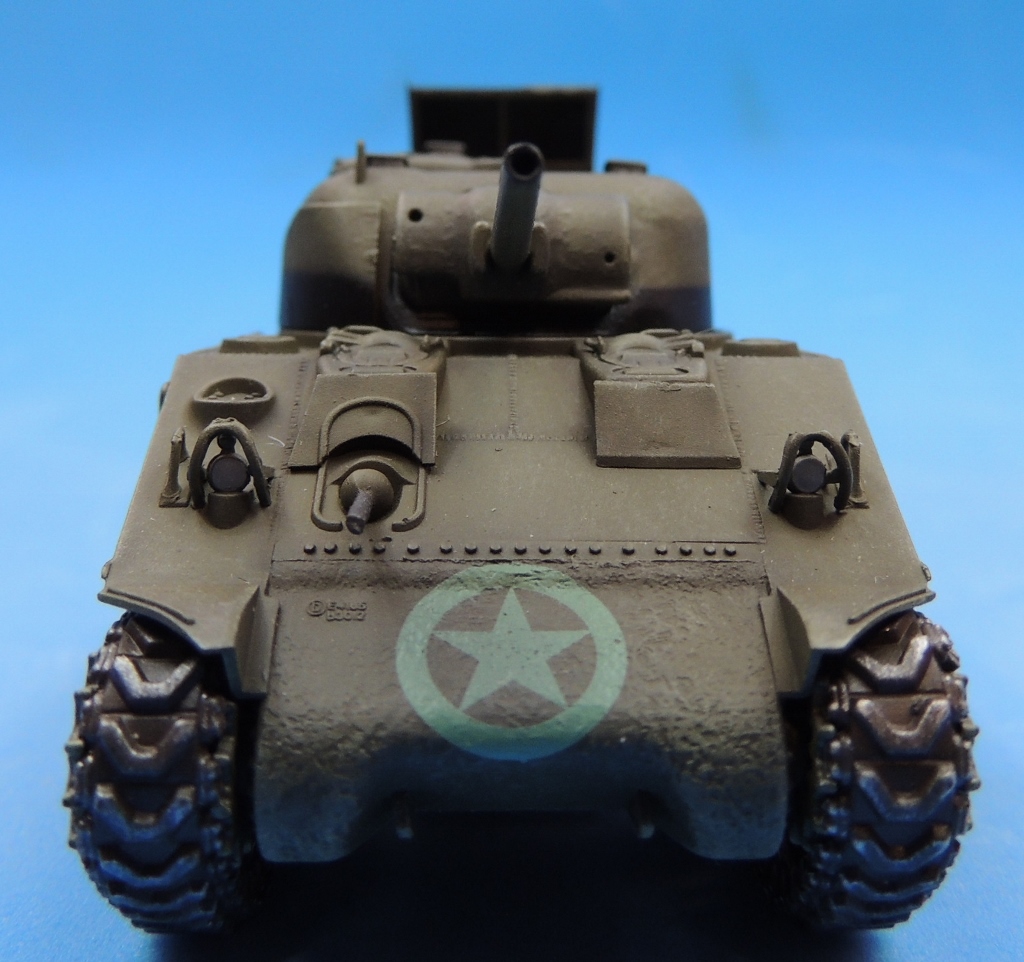
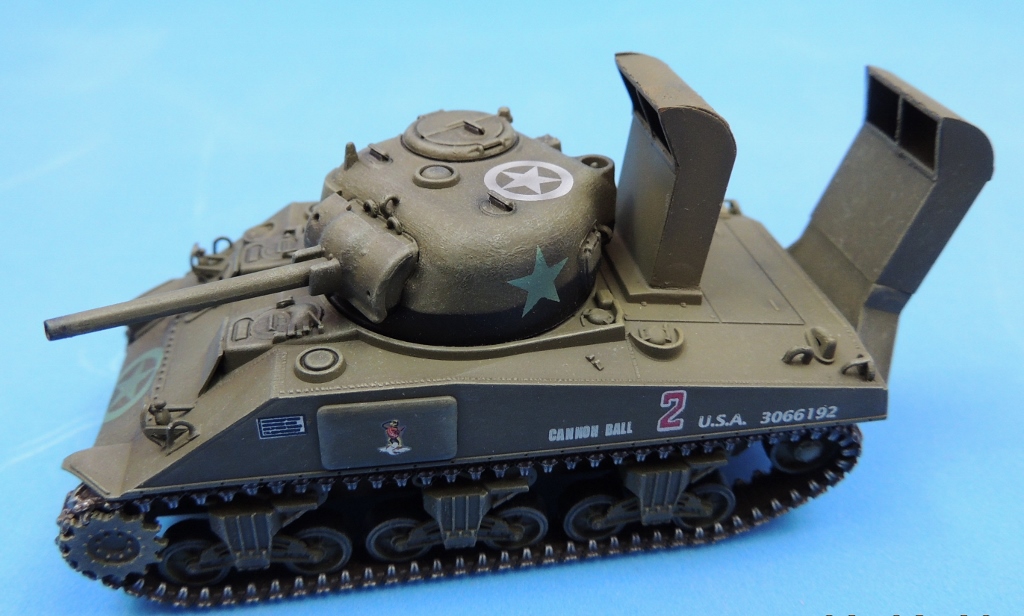
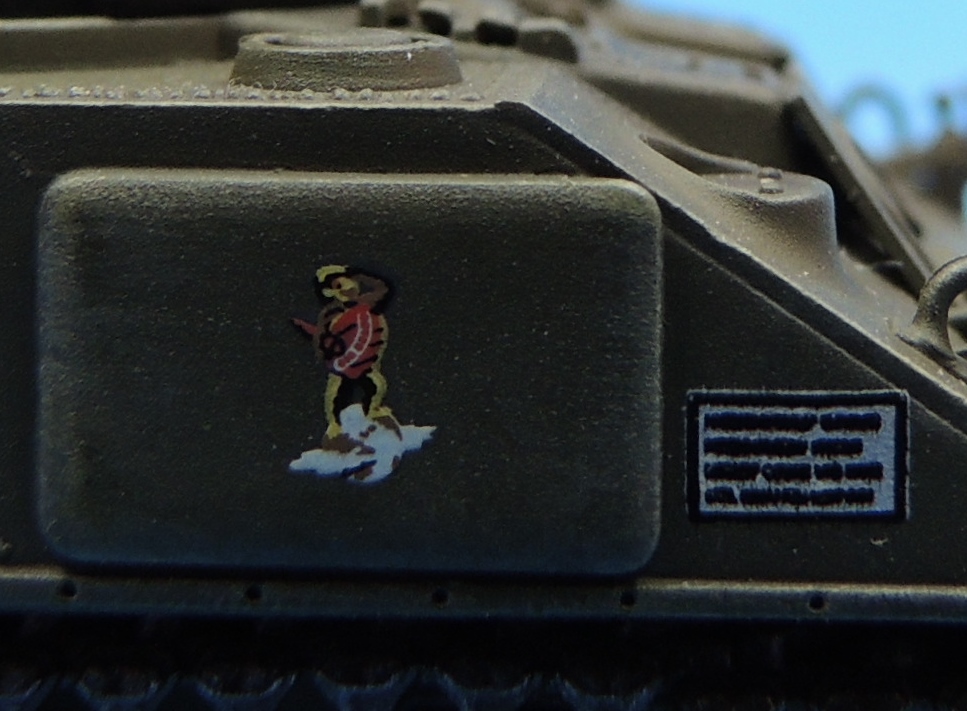
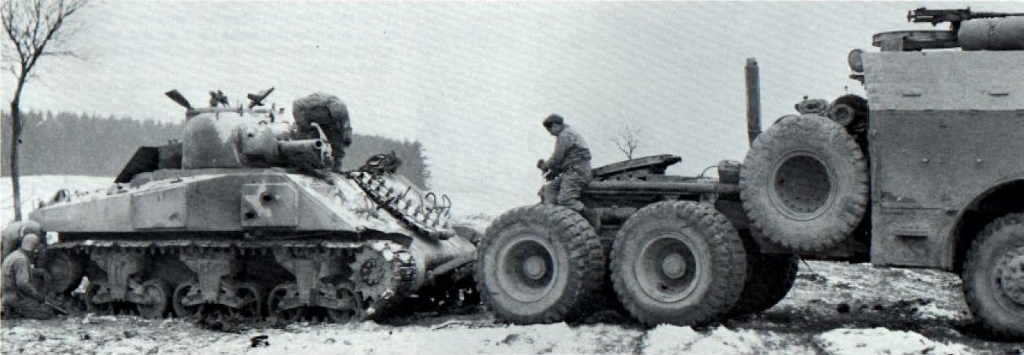

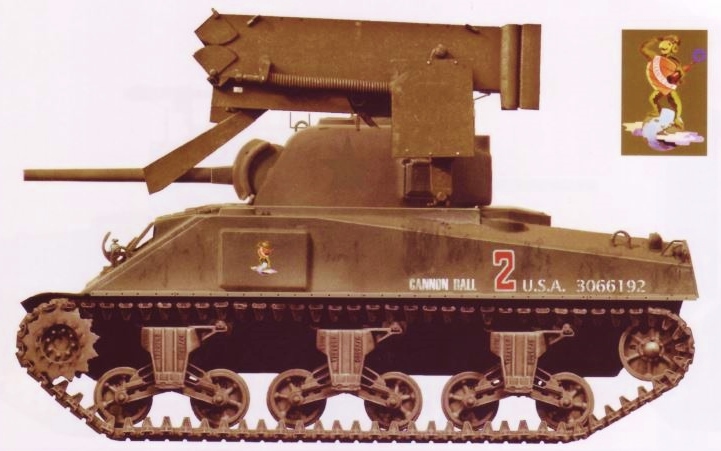
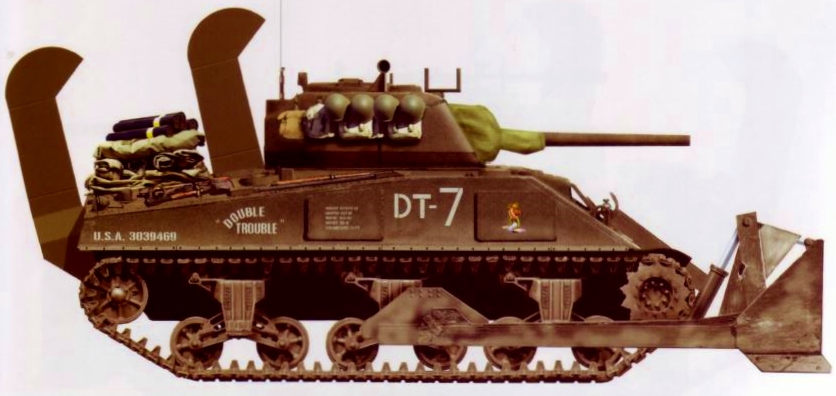

Kent Brazeau says:
Hello,
Can you tell me what the objects on the glacis below the drivers position are?
thanks
Kent
Veronica Viggiano says:
My husband’s cousin, 1st Lt. Nicholas Corrado was in the 70th Tank Division and died of his wounds in a German hospital on June 25, 1944. He is buried in the Brittany American Cemetery, Block D, Row 18, Grave 10. He was from Yonkers, NY. If anyone has any information about Nick, I would greatly appreciate hearing from them. Thank you for this excellent article.
will says:
Veronica, There is an account of the tank battle on 9 June 1944 where Lt. Corrado’s tank was destroyed and he was wounded in the book Strike Swiftly on pages 158 – 160. Basically, after two tanks in front of him were hit Lt Corrado was ordered by the Battalion Commander (Col. Welborn) to flank the German 88 anti-tank weapon that was shooting down the road. Lt Corrado left the road and proceeded to cross a field to flank the German 88 gun when his tank was hit by 5 Panzer Faust hand held anti-tank weapons from the woods on the left causing the tank to become disabled and eventually explode. Lt. Corrado and a couple other crewman in the turret managed to get out of the tank before it exploded. Lt. Corrado was taken prisoner where he ended up succumbing to his wounds in a local hospital used by the Germans. Interesting to note that Lt Corrado was not a trained tank Commander prior to D-Day. The 70th Tank Battalion was given 8 additional “Bulldozer” equipped tanks at the last minute and crews had to be found to staff them causing Lt. Corrado to have to learn how to command a tank on a Sunday right before the invasion. The incident however was not Lt Corrado’s fault as the Commander was pushing the tanks way out in front of the infantry exposing them to German infantry anti-tank weapons.
Catherine Gratton says:
In hopes that someone is moderating this website……..iam preparing a trip to normandy in anticipation of visiting the national cemetery to locate the grave of my uncle who died in the area very close to the end of the war. I have been trying to get as much information on his time in service. WILLIAM T. SCHOONOVER 70 tank division.
His cemetery marker # is row F, row 9 sec grave 38. Normandy . In my studies of the invasion i have not been able to pinpoint where he would have been. His wife (my aunt) has been deceased for many years and there are no longer living relatives to help. Can you steer me ? Catherine Gratton
Mischa Hecken says:
Hallo bin den in 1:16 als rc panzer am nachbauen toller Bericht und Bilder habt ihr noch mehr Bilder über den gefunden wäre wehr hilfreich eine Draufsicht wäre perfekt. Mfg weiter so.
Liebe Grüße Mischa
chules says:
Hello Mischa,
Thank you for the comment. I have no other photos of Cannon Ball but if any reader does, please feel free to post a comment and I’ll be sure to include it in the post.
Thanks so much,
chules
Charles Roberts says:
See page 185 of “Armored Strike Force” for another photo of “Cannon Ball” after it was recovered and in use in August 1944.
chules says:
Thank you, Charles, for the comment and for visiting the website. Most of all, thank you for publishing a book on such an important tank battalion. I bought the book as soon as it came out and thoroughly enjoyed it. And it’s fantastic to see never-before-published photos. I have incorporated the photo into the article. Again, thank you so much and congratulations on a great book.
Regards,
chules
James Brown Sr says:
Hi my name is James Brown Sr and my grandfather was Herman D Brown Sr. My grandfather was in the 70th battalion A company Armored strike force from D-Day to the bulge. I remember a lot of war stories from him as well as my father Herman D Brown Jr. My father was a doorgunner with the 770th assault helicopter company 52nd Buccaneers 1st aviation brigade from 1969-70. In all honesty its always been my dream to have both my father’s helicopter and grandfather’s tank in some kind of a model so plz get back to me with any info that can help me achieve this not only for my self but my mother and my children. Thank you
chules says:
Thank you for your email and for visiting the website. Your family has quite a military background and you’re a fortunate man. I’ll shoot you a message on the companies that make models of the wading kit sherman directly to your email address. In the meantime, you should be aware that Armored Strike Force, a book specifically on the 70th Tank Battalion, was published just this month (July 1, 2016). It’s a photo history with many previously unpublished photos provided by the families of those who served on the unit. It’s definitely worth a look. Here’s the link from Amazon: https://www.amazon.com/Armored-Strike-Force-American-Battalion/dp/0811717658/ref=sr_1_1?ie=UTF8&qid=1469984765&sr=8-1&keywords=70+tank+battalion
Regards,
chules
Mike says:
At least one more photo of “Cannonball” taken later in the campaign after it was retrieved can be seen in “Armored Strike Force, a History of the 70th tank Battalion” by Charles C. Roberts Jr., available in March 2016 or so, can be ordered now on Amazon. 272 pages, LOTS of photos, most by 70th personnel between 1940-1945. (not a book plug. Just of interest to 70th historians) – Mike
chules says:
Thanks for the info, Mike. Your comment just cost me $35 as I immediately pre-ordered the book from Amazon.
Mike says:
You’ll enjoy it. The author has a 70th Tank Btn Museum, and has attended the reunions for years.
Most of the photographs (negatives) were donated by the vets, or their families. Your money is well spent. Again, not a plug for the book. I have been a docent at the museum for 8 years.
My father did WWI aircraft in 1 7/2 scale for many years. Same idea, you can put many more on a shelf, or in a case. I remember him with magnifying glasses actually painting eyes on the pilots, and taking over a month (with research etc.) to do each model. I am impressed with the magnificent scenes recreated here, and wish I had the talent. I do 1/6 RC aircraft. – Mike
EY says:
Great work on the Sherman. I particularly like how you finished the tracks. I always struggle with how they should be colored,
Do the figures in the last picture come with the kit, or are they from elsewhere?
chules says:
Hi Eric.Thanks for the compliment but this is a pre-built Dragon Armor tank. I didn’t build it; I just bought it . My skills could not compare to the Chinese workers who built these. The figures in the last photo came with the also pre-built Dragon Armor 60233 Sturmtiger.
. My skills could not compare to the Chinese workers who built these. The figures in the last photo came with the also pre-built Dragon Armor 60233 Sturmtiger.